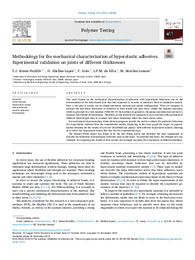Por favor, use este identificador para citar o enlazar este ítem:
https://hdl.handle.net/11000/33440Registro completo de metadatos
| Campo DC | Valor | Lengua/Idioma |
|---|---|---|
| dc.contributor.author | Simon Portillo, Francisco J. | - |
| dc.contributor.author | Abellan Lopez, David | - |
| dc.contributor.author | Arán, F. | - |
| dc.contributor.author | da Silva, Lucas | - |
| dc.contributor.author | Sánchez-Lozano, Miguel | - |
| dc.contributor.other | Departamentos de la UMH::Ingeniería Mecánica y Energía | es_ES |
| dc.date.accessioned | 2024-10-07T09:13:27Z | - |
| dc.date.available | 2024-10-07T09:13:27Z | - |
| dc.date.created | 2023-11 | - |
| dc.identifier.citation | Polymer Testing, Volume 129, December 2023 | es_ES |
| dc.identifier.issn | 0142-9418 | - |
| dc.identifier.uri | https://hdl.handle.net/11000/33440 | - |
| dc.description.abstract | This work focuses on the mechanical characterisation of adhesives with hyperelastic behaviour and on the determination of the behavioural laws that best represent it, in order to introduce them in simulation models. First, a test plan is carried out on simple specimens: uniaxial and planar configuration. These are designed to measure the non-linear behaviour of adhesives in both tensile and pure shear. Unlike the uniaxial specimen, which is governed by a test standard (UNE-ISO 37) that defines its geometry, the planar specimen does not have a standard that defines its dimensions. Therefore, in this research it is proposed to carry out tests with specimens of different width-length sizes to evaluate how these dimensions affect the stress-strain curves. For mechanical characterisation, finite element programs provide the tool to evaluate the predicted behaviour of a hyperelastic material from the experimental results, displaying in the same graph the degree of approximation obtained for the results of each test (Dumbbell and planar) with different hyperelastic models, allowing us to select the hyperelastic model that best fits the experimental data. The Mooney-Rivlin model was found to be the best fitting model and therefore the most appropriate to describe the behaviour of hyperelastic adhesives used in this study. To conclude this study, the obtained law was validated by comparing the results of tests carried out on single lap joint (SLJ) specimens of different thickness. | es_ES |
| dc.format | application/pdf | es_ES |
| dc.format.extent | 8 | es_ES |
| dc.language.iso | eng | es_ES |
| dc.publisher | Elsevier | es_ES |
| dc.rights | info:eu-repo/semantics/openAccess | es_ES |
| dc.rights | Attribution-NonCommercial-NoDerivatives 4.0 Internacional | * |
| dc.rights.uri | http://creativecommons.org/licenses/by-nc-nd/4.0/ | * |
| dc.subject | Finite element | es_ES |
| dc.subject | Hyperelastic models | es_ES |
| dc.subject | Characterisation | es_ES |
| dc.subject | Flexible adhesives | es_ES |
| dc.subject | Polyurethane | es_ES |
| dc.subject.other | CDU::6 - Ciencias aplicadas::62 - Ingeniería. Tecnología | es_ES |
| dc.title | Methodology for the mechanical characterisation of hyperelastic adhesives. Experimental validation on joints of different thicknesses | es_ES |
| dc.type | info:eu-repo/semantics/article | es_ES |
| dc.relation.publisherversion | https://doi.org/10.1016/j.polymertesting.2023.108286 | es_ES |

Ver/Abrir:
1-s2.0-S0142941823003665-main.pdf
4,5 MB
Adobe PDF
Compartir:
 La licencia se describe como: Atribución-NonComercial-NoDerivada 4.0 Internacional.
La licencia se describe como: Atribución-NonComercial-NoDerivada 4.0 Internacional.
.png)